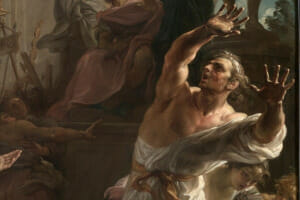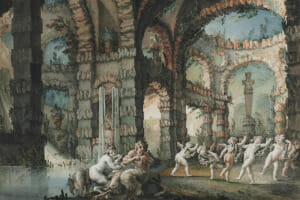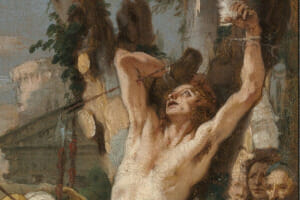Protesilaus: The Myth of the First Greek Hero to Step in Troy
 Protesilaus was a Greek warrior who hailed from the city-state of Phylace and bravely led his men into war against the Trojans. He was also a suitor of Helen, thus the war was his way of proving his love to her.
Protesilaus was a Greek warrior who hailed from the city-state of Phylace and bravely led his men into war against the Trojans. He was also a suitor of Helen, thus the war was his way of proving his love to her.
Though he fought bravely, Protesilaus died in the early stages of the war. Read on to discover the circumstances surrounding his death and how he came to be venerated in some Greek cities.
The Protesilaus Story
Born to Iphiclus and Diomedia, Protesilaus became the king of Phylace through his grandfather Phylacos, the founder of Phylace. Interestingly, his original name was Iolaus, however, because he was the first to set foot on Troy, his name was changed to Protesilaus (meaning first to leap ashore).
When he heard of the kidnap of Helen of Sparta by Paris, Protesilaus gathered warriors from the villages of Pyrasus, Pteleus, Antron, and Phylace into 40 black ships and sailed for Troy.
According to the myth, the gods had prophesied that the first to land on the shores of Troy would die. This struck fear in the hearts of all the Greek warriors, therefore, when they landed on the shores of the city of Troy no one wanted to disembark. Knowing that Troy would not be defeated if everyone stayed in their ship and being aware of the prophecy, Protesilaus sacrificed his life for Greece.
Odysseus was the first to disembark from his ship but knowing the prophecy, he threw his shield to the ground and landed on it. He was followed by Protesilaus who landed on his feet to face the Trojan army who were waiting for them on the shore.
With bravery and skill, Protesilaus managed to kill four Trojan warriors before he came face-to-face with the Trojan hero, Hector. The two champions from opposite sides of the war dueled till Hector killed Protesilaus, thus fulfilling the prophecy.
Protesilaus and Laodamia
Protesilaus was then replaced by his brother, Pordaces, who became the new leader of the Phylacian troops. Hearing of Protesilaus’s death, his wife, Laodamia, mourned him for days and begged the gods that they allow her to see her husband for one last time. The gods could not stand her constant tears any longer and thus decided to bring him back from the dead for three hours. Laodamia was filled with joy as she spent the time in the company of her husband.
Laodamia Makes a Statue of Protesilaus
After the hours had passed, the gods took back Protesilaus to the underworld leaving Laodamia broken and devastated. She just couldn’t bear the loss of the love of her life therefore she devised a way to keep his memory alive.
Protesilaus’s wife made a bronze statue of him and cared for it under the pretense of performing sacred rites. Her obsession with the bronze statue worried her father, Acastus, who decided to destroy the statue to save her daughter’s sanity.
One day, a servant brought in some delicacy for Laodamia, and peeping through the door he saw her kissing and caressing the bronze statue. He quickly ran off to inform Acastus that his daughter had found a new lover. When Acastus came to Laodamia’s room he realized it was the bronze statue of Protesilaus.
The Death of Laodamia
Acastus gathered stocks of wood and made them into a pyre. Once the fire was ready, he had the bronze statue thrown into it. Laodamia, who couldn’t stand the sight of the melting figurine, jumped into the fire with the statue to die with her ‘husband‘. Acastus lost his daughter to the blazing fire he had set up to destroy the statue.
The Elms on the Grave of Protesilaus
The Phylacias buried Protesilaus in the Thracian Chersonese, a peninsula between the Aegean sea and the Dardanelles strait. After his burial, the Nymphs decided to immortalize his memory by planting elms on his tomb. These trees grew so tall that their tops could be seen from miles away and were known as the tallest in the region. However, when the treetops reached the sights of Troy, they withered.
According to legend, the tops of the elms withered because Protesilaus was so bitter towards Troy. Troy had robbed him of all that he held dear. First, it was Helen who was abducted by Paris, then he lost his life as he fought to rescue her from her captives.
He also lost his dear wife to the blazing fire as a result of his adventures on the battlefield. Thus, when the trees buried on his grave rose to the heights when they could ‘see’ the city of Troy, the tops withered as a sign of Protesilaus’s grief.
The Poem Protesilaus by Antiphilus of Byzantium
A poet named Antiphilus of Byzantium, who knew about the elms on the grave of Protesilaus captured the whole phenomenon in his poem found in the Palantine Anthology.
[: Thessalian Protesilaos, a long age shall sing your praises
Of the destined dead at the Troy first;
Your tomb with thick-foliaged elms they covered,
The nymphs across the waters from hated Ilion (Troy).
Trees full of anger; and whenever that wall they see,
Of Troy, the leaves in their upper crown wither and fall.
So great in the heroes was the bitterness then, some of which still
Remembers, hostile, in the soulless upper branches.]
The Shrine of Protesilaus at Phylace
 After his death, Protesilaos was venerated in his own city of Phylace at the spot where Laodamia spent days mourning him. According to the Greek poet Pindar, the Phylacians organized games in his honor.
After his death, Protesilaos was venerated in his own city of Phylace at the spot where Laodamia spent days mourning him. According to the Greek poet Pindar, the Phylacians organized games in his honor.
The shrine featured a statue of Protesilaus standing on a platform shaped like the front of a ship wearing a helmet, armor, and a short chiton.
The Shrine of Protesilaus at Scione and Its Myth
Another shrine of Protesilaus was located at Scione in the Kassandra Peninsula albeit with a different narration of what happened to Protesilaus in Troy. According to the Greek mythographer, Conon, Protesilaus did not die at Troy but captured Aethilla, the sister of the Trojan king, Priam.
His warriors also followed suit by capturing other Trojan women. Whiles returning to Phylace with their captives, Aethilla ordered the Trojan women to burn the ships when they rested at Pallene.
Pallene was a place along the shores between the towns of Scione and Mende. The activities of Aethilla and the Trojan women forced Protesilaus to flee to Scione where he found and established the city. Thus, the cult of Protesilaus in Scione venerated him as the founder of their city.
Historical Documents Mentioning the Shrine of Protesilaus
Surviving texts from the 5th Century BCE mention Protesilaus’ grave as a place where the Greeks buried votive treasures during the Greco-Persian War. These votive treasures were later discovered by Artayctes, a Persian general, who pillaged them with permission from Xerxes the Great.
When the Greeks discovered that Artayctes had stolen their votive treasures, they chased after him, killed him, and returned the treasures. The tomb of Protesilaus was once again mentioned in the adventures of Alexander the Great.
According to the legend, Alexander stopped at the tomb of Protesilaus on his way to fight the Persians and offered a sacrifice. The legend has it that Alexander offered the sacrifice to avoid what happened to Protesilaus in Troy. Once he got to Asia, Alexander was the first to step on Persian soil just like Protesilaus. However, unlike Protesilaus, Alexander survived and conquered much of Asia.
Aside from the surviving historical documents mentioned above, a large silver coin, known as tetradrachm, from 480 BCE Scione features Protesilaus. The coin can be found in the British Museum in London.
Depictions of Protesilaus
The Roman author and historian, Pliny the Elder, mentions a sculpture of Protesilaus in his work, Natural History. There are other two notable copies of Protesilaus’ sculptures from around the 5th Century; one is at the British Museum while the other is at the Metropolitan Museum of Art in New York.
The sculpture at the Metropolitan Museum of Art features Protesilaus standing in the nude wearing a helmet and leaning slightly to the left. His right arm is raised in a pose that suggests he is ready to strike a blow with a piece of cloth draping over the left side of his body.
Comparing Protesilaus and Zephyrus
Some people contrast the character of Protesilaus with Zephyrus to draw similarities and differences. In Greek mythology, Zephyr was the god of the gentlest wind also referred to as the continental tropical air mass. The Greeks believed he resided in a cave in Thrace and had many wives according to several legends. In one legend, Zephyrus, also known as Zephyr, kidnapped the nymph Chloris and put her in charge of flowers and new growth.
Zephyrus and Chloris then gave birth to Karpos whose name means “fruit“. Thus, the story is used to explain how plants fruit in the springtime – Zephyr the west wind and Chloris come together to produce fruits.
Though Zephyr was thought about only his pleasures, Protesilaus was seen as a brave unselfish man. Similarly, both of them were ambitious but their ambition was driven by different motives; Protesilaus wanted to be a hero while Zephyr just loved himself.
Though both characters do not meet in the Iliad or any Greek mythology, they are both revered in their respective roles. Protesilaus sacrifices himself for the good of Greece and Zephyr through his many marriages provides food, flower, and gentle winds for the Greeks. However, Zephyrus is more selfish compared to Protesilaus due to the former’s jealous nature and unwillingness to sacrifice his pleasures.
Lessons From the Myth of Protesilaus
Sacrifice for the Good of Society
From the story of Protesilaus, we learn the art of sacrificing for the good of society. Though Protesilaus knew of the prophecy, he went ahead to take the first step so that Greece can conquer Troy. He left behind his family and wife who loved him dearly to embark on the journey of no return. He was a typical Greek warrior who preferred death on the battlefield to the shame that came with cowardice.
The Danger of Obsession
Through the story of Laodamia, we learn the danger of being obsessive. Laodamia’s love for her husband grew into an unhealthy obsession which eventually led to her death. Love is a great emotion that should not be allowed to grow unchecked. Also, learning to control our passions regardless of how indulging and engulfing they are, will be of great help.
Strength And Bravery in the Face of Fear
The hero showed strength and bravery when confronted with imminent death. It is easy to imagine what went through his mind as he battled with the decision to step on Trojan soil. He could have allowed fear to cripple him just as it did the other Greek heroes. Once he landed on the shores of Troy, he did not cower in terror but bravely fought and killed four soldiers until he finally died at the hands of the greatest Trojan warrior, Hector.
Conclusion
 So far, we’ve discovered the myth of Protesilaus Troy and how he was enshrined in Greek mythology as one whose sacrifice helped in conquering Troy.
So far, we’ve discovered the myth of Protesilaus Troy and how he was enshrined in Greek mythology as one whose sacrifice helped in conquering Troy.
Here is a recap of what we’ve read so far:
- Protesilaus was the son of King Ioclus and Queen Diomedia of Phylace.
- He later became King of Phylace and led an expedition of 40 ships to help Menelaus rescue Helen from Troy.
- Though an oracle prophesied that the first person to step his foot on Trojan soil would die, Protesilaus went ahead to sacrifice himself for Greece.
- He was killed by Achilles and his cult established shrines both at Scione and Phylace.
- From the story, we learn the rewards of sacrifice and the danger of unhealthy obsessions.
The myth of Protesilaus is a good illustration of the philosophy of ancient Greek warriors who placed honor and glory before personal gain. They believed that by sacrificing themselves on the battlefield, their memories would be immortalized just like the hero Protesilaus.

